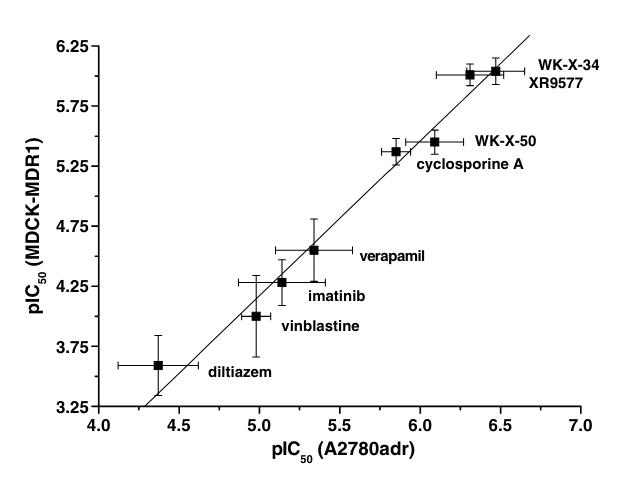Human Transporter P-gp Fluorescence-based Antagonist Assay Service
Mastering P-glycoprotein (P-gp) Interactions for Superior Drug Development
Creative Biolabs provides comprehensive services to support our clients' projects in immunotherapy development, which include In Vitro ADME, featuring the Analysis of Drug-Drug Interactions, which encompasses:
P-gp is a critical membrane transporter that plays a significant role in the absorption, distribution, metabolism, and excretion of various drugs. The modulation of P-gp activity can greatly influence the pharmacokinetics and pharmacodynamics of therapeutic agents, affecting their efficacy and safety. At Creative Biolabs, we pride ourselves on turning in top-tier human transporter P-gp fluorescence-based antagonist assay offerings. With full-size enjoy in drug improvement and ultra-modern generation platforms, we ensure specific and dependable drug screening solutions. Our professional crew makes use of advanced fluorescence detection strategies to as it should be investigate drug interactions with P-gp, providing extremely good data and insightful evaluation to aid your drug improvement system.
Our human transporter P-gp Fluorescence-based antagonist assay service is designed to provide an in-depth evaluation of drug interactions with the P-glycoprotein transporter. This assay offers a functional, cell-based approach, using MDCKII cells to measure the antagonist activity of drug candidates.
Assay Information:
|
Substrate
|
Assay Type
|
Cell Type
|
Functional Mode
|
Detection Method
|
Measured Response
|
|
Calcein AM
|
Functional
|
MDCKII Cell
|
Antagonist
|
Fluorimetry
|
Fluorescence
|
In this study, P-gp-expressing MDCKII cells are treated with the desired compounds and the fluorescent substrate calcein AM. In general, P-gp actively transports calcein AM out of cells, resulting in decreased cell luminescence. Acting as an antagonist, the candidate compound inhibits P-gp activity, leading to increased intracellular accumulation of calcein AM, which in turn increases the fluorescence intensity
The method of detection is fluorometry, which accurately measures the activity of the fluorescence. This provides a quantitative assessment of the effects of the drugs on P-gp. Using this cell-based activity assay, we can determine the precise interaction of drug candidates with the P-gp transporter, providing important insights into their pharmacokinetics for function, viability, and safety issues
Published Data
This study reports pIC50 values for eight different substances assessed using the calcein AM assay. This assay measures the inhibition of P-glycoprotein activity by drug candidates, reflected in changes in intracellular fluorescence of calcein AM. The obtained pIC50 values provide quantitative insights into the potency of these substances in inhibiting P-gp-mediated efflux, crucial for predicting drug interactions and optimizing therapeutic efficacy. This data enhances our understanding of P-gp modulation and supports the development of strategies to overcome drug resistance in clinical applications.
 Fig.1 Scatterplot of the pIC50-values of eight different substances obtained in the calcein AM assay.1
Fig.1 Scatterplot of the pIC50-values of eight different substances obtained in the calcein AM assay.1
Applications
-
Understanding how drug applicants engage with P-gp can useful resource in optimizing their pharmacokinetic profiles to decorate efficacy and reduce toxicity.
-
Evaluating capacity interactions with P-gp helps expect and prevent unfavorable drug-drug interactions.
-
Insights into P-gp interactions are important for correct pharmacokinetic modeling and prediction.
-
Identifying P-gp interactions contributes to assessing the safety and toxicity profiles of drug applicants.
Advantages
-
Use of fluorimetry with the calcein AM substrate, taking into consideration targeted and quantitative assessment of P-gp hobby.
-
Providing a complete evaluation of the antagonist results on P-gp, reflecting practical biological interactions.
-
Rapid and unique measurements
-
Significantly improving the drug improvement system, mainly to the optimization of therapeutic candidates and the identity of ability problems early within the development pipeline.
Our expert group guarantees cautious research and thorough investigations, presenting awesome, dependable records to aid your scientific offerings. Through our human transporter P-gp fluorescence-based antagonist screening service, we provide vital records to useful resources within the optimization and successful improvement of healing candidates, ensuring that their strong interplay with P-gp is tested. Contact Creative Biolabs for up-to-date human transporter P-gp fluorescence-based totally antagonist assay offerings. Our committed and experienced crew is devoted to supplying the best great carrier, with accurate statistics and insightful evaluation to ensure the fulfillment of your medical practice.
Reference
-
Müller, Henrik, et al. "New functional assay of P-glycoprotein activity using Hoechst 33342." Bioorganic & medicinal chemistry 15.23 (2007): 7470-7479.
For Research Use Only | Not For Clinical Use


 Fig.1 Scatterplot of the pIC50-values of eight different substances obtained in the calcein AM assay.1
Fig.1 Scatterplot of the pIC50-values of eight different substances obtained in the calcein AM assay.1
 Download our brochure
Download our brochure